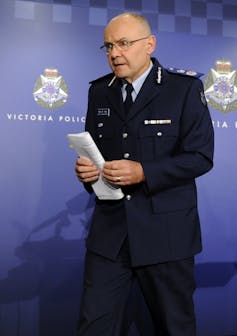Did the grim story of dapper real estate agent Gerard Baden-Clay’s calculated murder of his wife Allison in April 2012, played out recently in a Brisbane court with a life sentence, make you feel afraid? Did it make you feel as if the norm of men caring for their partners and children has flipped to a darker side, where filicide and homicide are creeping into what was once the centre of safety?
You would, in truth, be justified in your fears. We know the statistics now; they are no longer a closely guarded secret, ignored as “domestics” by the police and the media. Intimate partner violence is the leading cause of preventable death, illness and disability in Victorian women aged 15-44 – more than smoking or obesity or illicit drugs or alcohol.
Violence against women is a largely hidden problem, yet manifests in and forms part of the backdrop to most other more visible health issues. The cost of violence against women to the Australian economy, including direct and indirect physical and mental health services, is estimated to rise to A$15.6 billion a year by 2021.
It is, one would think, the biggest crime story in Australia and one of our biggest social and economic stories. Yet until recently, mainstream media did not consistently or prominently report violence against women. Why not?
Entrenched social attitudes
Until recently, the media weren’t interested in reporting domestic violence. Journalists didn’t see “domestics” as a story. The reason for this seems to be that the media hold the same negative attitudes to women that have been globally recognised as contributing to violence against them in the first place.

This is of concern, since media play a key role in forming societal attitudes to gender and gender roles.
The attitudes identified as harmful to women – shared by some newsrooms and some of the Australian populace – are what we would call “blokey” and sexist. According to Victoria Police Chief Commissioner Ken Lay:
The figures stem from some pretty sick attitudes towards women, attitudes of sexual entitlement and possessiveness, attitudes of supposed female inferiority. Many of those attitudes are reinforced in the workplace – subtly or overtly – and they influence vulgar or criminal behaviour.
Lay’s comments are backed by international and Australian research. The findings show that men perpetrate violence against women because they hold negative attitudes towards them, believe in traditional masculinity and male privilege, believe in rigid gender roles, operate in a society of masculine dominance, and have weak support for gender equality.
Overall, a lack of balance of power between men and women underlies men’s violence against women. According to the World Health Organisation:
… the unequal position of women relative to men and the normative use of violence to resolve conflict are strongly associated with … intimate partner violence.
A male-dominated media
Australian media have a balance of power tipped overwhelmingly towards men, according to the most recent study of who owns, runs, influences, reports, presents and creates the news. Only one mainstream Australian media organisation of 15 identified by the study as “big”, Bauer Media, had a female chairperson. Nine Entertainment, provincial publisher APN and Seven West Media now have just one female board member apiece.
No woman edited a weekday daily or national metro publication at the time of the study (March 2013). Across 418 newspapers Australia-wide, 61% of editors were male. Across nine metropolitan and regional newspapers on a given day, March 4, 2013, 461 of 591 of all bylined stories had a male byline.
These results are in line with global research across all “legacy” media. A recent analysis of American newscasts revealed that male reporters were assigned more hard news than female reporters, who were more likely to be assigned soft news. Both male and female reporters used more male sources as experts in hard news. The study’s author, Mariah Irvin, concludes:
The implications of the results of this study include female under-representation as reporters and sources, probably continuing a perception of women as being in a lower social status than men.
European studies have also found female news sources to be strongly stereotyped and limited to traditional “female” topics.
At the same time, ethnographic accounts of the newsroom in Australia and surveys of female journalists have suggested that newsrooms are sexist workplaces. Australian female journalists experience twice the rate of sexual harassment by a male colleague or senior male manager compared with other workplaces. These gender issues appear to be reflected in news values and decisions, and are stubbornly resistant to change.
Hope for change?
The way in which intimate partner violence has been covered by Australian media is, in its paucity, lack of context and superficiality, a strong example of these newsroom gender issues. A Victorian study in 2012 found that incidents of violence against women are reported as if they are random acts from people “with problems” (not as part of a broader, gender-power problem affecting us all). There was an unrepresentative focus on “stranger danger”.
The study also found that reportage of intimate partner violence was largely absent; that intimate partner rape was 40 times less likely to be reported in the media than rape by a stranger; and that the experts quoted in news reports were police and courts, not workers in the field of family violence.

Two interesting developments in the media in Australia may allow more balanced, ethical and accurate reporting of men’s violence against women. One is new media, which, with their horizontal power base and heterogeneity of decision-makers and reporters, allow (in theory) a bypass of the male gender power base of legacy media.
The rape and murder of 29-year-old Jill Meagher in Melbourne in September 2012 signalled the second development: a turning point in mainstream media coverage of violence against women. Since then, Melbourne’s Herald Sun newspaper has taken a conscious leadership role in reporting on and campaigning on violence against women.
The Centre for Advancing Journalism is working with the Herald Sun to research how these changes in news priorities occurred. Cursory reporting of violence against women has evolved to the “Take a Stand” campaign and associated in-depth, consistent and contextual reporting.
Perhaps what is learnt from this research into changes in newsroom practice in the face of entrenched gender power norms across the industry will introduce balance, accuracy, context and respect in reporting the gravity of Australia’s most frightening crime story.
The National Sexual Assault, Family & Domestic Violence Counselling Line – 1800 RESPECT (1800 737 732) – is available 24 hours a day, seven days a week for any Australian who has experienced, or is at risk of, family and domestic violence and/or sexual assault.
Read the other articles in The Conversation’s Domestic Violence in Australia series here.
Editor’s note: On December 8, 2015, Gerard Baden-Clay’s murder conviction was set aside and substituted for manslaughter.

